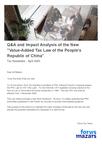
April 2025 - Q&A and Impact Analysis of the New "Value-Added Tax Law of the People's Republic of China"
The Law merely provides a high-level framework. As such, it is widely expected that PRC authorities supplement it with further tax circulars to provide more detailed guidance.
The purpose of this article is to highlight the major changes introduced by the new Law and discuss the possible implications for taxpayers in a Q&A format.
Q1: Are there any changes in the scope of charge of VAT?
In general, there are no major changes in this regard. The new Law outlines 4 types of taxable transactions which include namely the sale of a) goods b) services c) intangible assets and d) immoveable properties in China plus the import of goods.
Compared to the previous regulations, the new Law incorporates processing, repair and maintenance labor under the category of “services”.
Another notable change concerns the definition of taxable transactions occurring in China. For the above transactions to be taxable under VAT Law, those transactions must occur within China.
Article 4 of the new Law speculates that taxable transactions occurring in China refers to any of the following circumstances:
- For the sale of goods, the place of departure or the locations of the goods is in China;
- For the sale or lease of immovable property or the transfer of the right to use natural resources, the location of the immovable property or nature resources is in China;
- For the sale of financial products, the financial products are issued in China, or the seller is an entity or individual in China;
- Except for the items 2) and 3) of Article 4, for the sale of services or intangible assets, the services or intangible assets are consumed in China, or the seller is an entity or individual in China.
While items 1 and 2 have no substantial changes, items 3 and 4 may need attention.
In the past, there was controversy over whether a foreign company selling red chip stocks to a PRC company should be subject to PRC VAT. It is now clear that such transactions are not subject to PRC VAT. Likewise, the treatment of transactions where the service providers or the service recipients are located in China will change.
However, on the other hand, the tax authorities shall clarify the meaning of “services consumed in China”.Currently, it is not clear and shall create uncertainties without further clarifications.
Q2: What are the changes in non-deductible input VAT?
Article 22 of the Law states that the following input VAT shall not be offset against output VAT:
- Input VAT amounts corresponding to taxable items subject to the simplified tax calculation method;
- Input VAT amounts corresponding to VAT-exempt items;
- Input VAT amounts corresponding to abnormal loss items;
- Input VAT amounts corresponding to goods, services, intangible assets, and immovable properties purchased for collective welfare or personal consumption;
- Input VAT amount corresponding to catering services, daily services for residents and entertainments purchased for direct consumption;
- Other input VAT amounts stipulated by the State Council.
The Law removes the restriction that “purchased loan services” cannot be used to offset input VAT, thereby reserving possible space for VAT reduction in this aspect. However, it depends on whether the State Council would further restrict the input VAT credit in this regard in the future.
Q3: Are there any changes in deemed VAT transactions?
Article 5 only sets out the following circumstances as deemed VAT transactions:
- Use of self-produced goods or goods produced on processing trade by an entity or household individual business for collective welfare or personal consumption;
- Free transfer of goods by an entity or household individual business;
- Free transfer of intangible assets, immovable or financial products by an entity or household individual business.
The Law significantly reduces the scope of deemed VAT transactions, retaining only 3 scenarios as opposed to the 8 specified in the current Provisional Regulations on VAT.
It is expected that certain deemed sales in the past would need further clarification. For example, physical transfer of goods from headquarters to branches in different cities is currently considered as deemed sales for VAT purposes. It may cause a situation where the headquarters is always having input VAT for deduction while no input VAT credit is available for the branches.
Q4: Any changes in mixed sales for VAT purposes?
Article 13 of the Law sets out that where a taxable transaction of a taxpayer involves 2 or more tax rates or levy rates, the tax rate or levy rate (as the case may be) applicable to the principal business of the taxable transaction shall apply.
The concept of mixed sales has been amended. Previously, mixed sales primarily targeted combinations of goods and services only. Other combinations such as the sales of goods and the sales of immovable property would also be considered as mixed sales.
The PRC tax authorities should clarify how to determine the principal business of the concerned taxable transaction for mixed sales transactions.
Q5: Any changes in VAT rates and levy rates?
For VAT rates, the new Law still adopts 6%, 9% and 13% without changes. For levy rate, the Law does not mention the 5% rate currently applied to certain transactions using simplified calculation method. It is widely speculated that the 5% levy rate would be replaced with a 3% rate.



